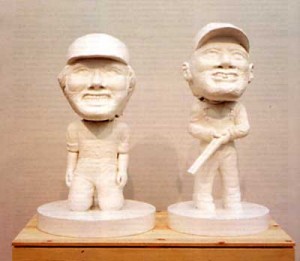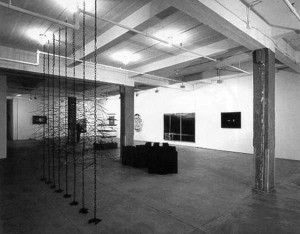For ‘NYArts’ Magazine

Melissa Chiu is a curator’s curator. Headhunted from her native Australia by the Asia Society and Museum, the thirtysomething Chiu has just become the first museum curator of contemporary Asian art in the United States. Over the past ten years, she not only founded a non-profit gallery space in Sydney but also curated over twenty exhibitions at other alternative gallery spaces in Australia. Chiu will even admit to loving the art of curating as much as the visual arts themselves.
“I think it’s generational,” she explained. “When I was at university…I was trying to find literature on curatorial practice, and there was not a lot in the early 90s…I was quite curious about this idea of curatorial practice being as much a practice as artistic practice.” One of Chiu’s early exhibitions, ‘Anthology: Six Perspectives on Curatorship’ positioned six curators for a period of a week each in the gallery space. By curating an exhibition of both curatorial practice and artwork, Chiu aimed to drag usually hidden organizational processes under the gallery floodlights. Since then, whether she is focusing on Australian, Asian or multi-ethnic artists, there is an underlying sensitivity to who has put the show together and why.
Chiu came on board at the Asia Society and Museum in September, a few months before the organization reopened in its renovated space. She has inherited the Museum’s ambitious commitment to contemporary art, evidenced most recently by the long-term installations commissioned from a number of internationally known Asian contemporary artists. On the opening day, Chiu led a panel discussion, during which Heri Dono from Indonesia introduced his flying cocoons, Vong Phaophanit explained how living in France and now England for much of his adult life influenced his neon and beeswax sculpture, and Indian artist Nilma Sheikh discussed her long scrolls, which hang from the third floor down to the lobby on the open staircase. Rounding out the new commissions is work by Yong Soon Min from South Korea, Navin Rwanchaikul from Thailand, Shahzia Sikander of Pakistan and New York, Sarah Sze from Boston and Xu Bing and Xu Guodong, both from China.
The new curator will finally come into her own with two shows planned for September. First, the Asia Society will host ‘The Native Born: Objects and Images from Ramingining, Arnhemland,’ a traveling exhibition of Aboriginal art curated by Djon Mundine, a world expert on Aboriginal art. Fusing the traditional and contemporary is the m.o. at the Asia Society, and at the same time as the Aboriginal art show, Chiu will curate her own show of porcelain busts by Chinese artist Ah Xian. Ah, one of the many Chinese artists who moved to Sydney after the Tiananmen Square massacre in 1989, recently won Australia’s National Sculpture Prize, and although his work has been exhibited widely in Asia, this will be his first show in New York. Working with master potters and painters in the Jingdezhen, China, Ah uses the uniquely Western art form of the portrait bust and makes a number of Eastern adaptations. The sculptures are made of porcelain, depict Asian likenesses, and are painted in traditional Chinese designs.
Like Ah Xian, Chiu works at the intersection of cultures. And like the Asia Society’s combination of artists from eight different countries in its recent commissions, she will have to juggle the personal and national concerns of artists from around the world. Born in Australia to a Chinese father and Australian mother, Chiu has first hand experience of living simultaneously in two cultures, an experience with relevance for her professional life. Before leaving Sydney for New York, she was the founding director of the Asia-Australia Arts Centre, a non-profit art exhibition space established to support the work of Asian contemporary and Asian-Australian artists. “We had an interesting curatorial premise to provide these artists with a working environment that wasn’t exclusively Asian,” Chiu explained. “We wanted to create a broader context and perspective of Asian art and culture that wasn’t exclusive or ghettoizing.”
With a strong background in Asian-Australian art, and the Asian and Australian art scene, why did Chiu choose to give it all up and move to New York? “The idea of curating significant exhibitions of contemporary Asian art was a real lure for me,” said Chiu. “Australia for the last decade really focused itself on the Asia Pacific region and becoming part of that, so there are lots of really significant things that have been done but which aren’t known elsewhere. So there is the idea of engaging with a broader audience.” And if traveling to the other side of the world to start a new job doesn’t keep her busy enough, Chiu is also finishing a PhD on contemporary Chinese artists. The focus is on the diasporic communities in Sydney, New York and Paris, particularly how the artists’ work has been affected by the change in context.
It seems fitting that Chiu would eventually be employed by the US institution that presented the influential 1994 show ‘Asia/America,’ of work by ex-pat Asian artists living in the US. And one of the most significant shows of contemporary Asian art to date in the US, ‘Inside Out’, was also organized by the Asia Society along with the San Francisco Museum of Modern Art. This second exhibition of work by Chinese artists took place in 1998-99, after a decade of major shows of Asian art in Europe. At first slow to catch on to the rising interest in contemporary Asian art, the US audience has since embraced several major Chinese and Asian artists. However, Chiu sees an element of following the fashion in this. “When it settles down ultimately, there are probably only three or four artists who get remembered. They are the ones who are still on an international circuit or who have representation from major galleries, like Xu Bing, Zhang Xiaogang and Zhang Huan…And they have in many ways a higher profile than a lot of the Asian-American artists.”
Back in Australia, in her work at the Arts Centre and in many independent exhibitions, Chiu championed the work of Asian-Australian artists. Time will tell if this ends up translating into an interest in Asian-American artists. Coincidently, before she left for New York, Chiu was developing an exhibition that would include some comparative views of artists from Asian origins in both the U.S. and Australia. But whatever the future holds for contemporary art shows at the Asia Society and Museum, it looks promising. The new commissions, the hosting and organizing of landmark exhibitions, and the creation of Chiu’s position are signs that the commitment to putting contemporary Asian art on the map in New York has grown stronger. With her considerable experience and drive, Chiu seems up for the job.


